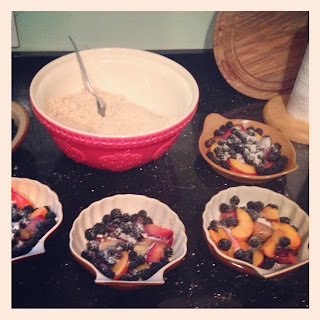So yesterday I attempted pasta for the first time ever. Yes, Mum, that means that I have finally used your Christmas present of the pasta machine after all these years!
My attempt went very, very well and apart from the first batch sticking to the work surface, there were no problems at all. I'd definitely make it again tomorrow - it was that easy! Honestly!

I started out by drying out the tomatoes in a 100 degree oven (low temp) and left them in there for a couple of hours while I cook.
Next, I started the pasta dough. I used a Georgio Locatelli measurement which was 300g '00' flour to 3 eggs and 2 egg yolks. The Italian '00' flour is meant to be better for pasta.

Make a well with the flour and add the eggs into it. Use fingers to stir the eggs gradually into the flour in a circular motion.
Once it comes together, knead well for 10 minutes. Push down with the
heel of your hand, bring it back and quarter turn it every time. You'll
soon get into a rhythm and it'll get smoother but still quite tough to
knead. Once smooth to touch and you're out of breath (kneading should
require you to get a slight sweat on otherwise you haven't put enough
into it!), then cut into two parts and leave to rest in damp cloths.
Leave to rest for an hour or so while you make the filling. I've put toegther onions, mushrooms and the leftover roasting beef from
Sunday's roast. I sauted onions with a few whole garlic cloves then added a glass of red wine and reduced right down to a tablespoon then added mushrooms to sweat down a bit, then tomato puree, some oregano, salt and pepper and then finally the beef. I didn't want to cook the beef very much as it is already cooked and I will be boiling it within the ravioli later.
Next, I made the pesto oil by mixing pesto (pine nuts/parmesan/basil/garlic/olive oil/salt/pepper) with more olive oil to make it into a drizzle consistency.
By this time, I had time to sit for 10-15 mins while the rest of the pasta rested and enjoyed a glass of red.
Once the pasta has rested for an hour, it's time to roll it out. With one of the halves, start with a rolling pin so it's gets to about a centimeter in a oblong shape. Then, feed into the largest width on the pasta machine and after two feeds on the widest width move to a smaller size each time. Gradually get down to the thinnest you can manage - I got to 8 out of 10 on my pasta machine scale. I could slightly see through it and this is plenty thin enough. Make sure you flour every surface and even the machine. It gets hot and will start to stick to everything so work quickly but carefully.

Once rolled out, lay flat and put your filling in little blobs along the sheets. Then carefully lay the second sheet over the top and squidge all the air round the edges. Any air left in the ravioli will burst when you boil them. I used a ravioli cutter here to trim the edges but a knife will do - just make sure to seal the edges firmly.
Here, you can see I've made two strips, one single ravioli and one double ravioli, it just depends on how the pasta rolls out. Little tip from the Italian: prick any air bubbles with a cocktail stick and then seal it back up with a little pinch. Also, semolina would also help instead of flour (it's traditionally used but I had flour in the cupboard).
I ended up with about 25 pieces of ravioli, and about 5 had to be thrown
as the holes that I made in them couldn't be patched up.

Boil the ravioli for 5 minutes, putting in one at a time, in the biggest saucepan of hot water you can muster (with a big pinch of salt in). Test a corner of one to check, then dress your plate and serve with the leftover vino.
So, here you have it: my final dish. Beef ravioli with pesto oil, oven-dried tomatoes, and mascarpone. I've served it with a parmesan and rocket salad with a balsamic dressing. My italian neighbour loved it and I even got high praise from her Mum! Successful evening in the kitchen!

So, turn away from that takeaway menu tonight and get creating: it's cheaper and way more rewarding!
ZP x
















































